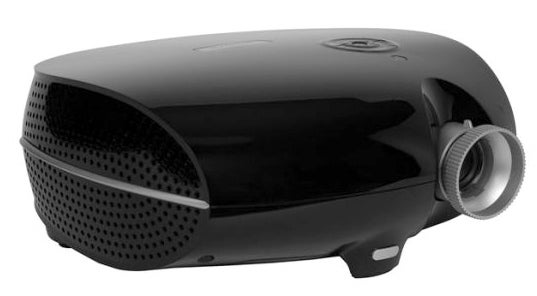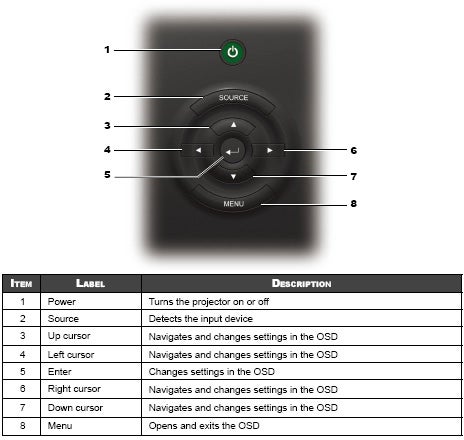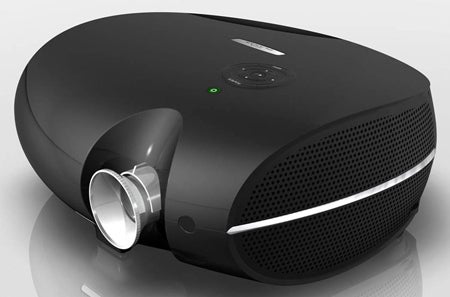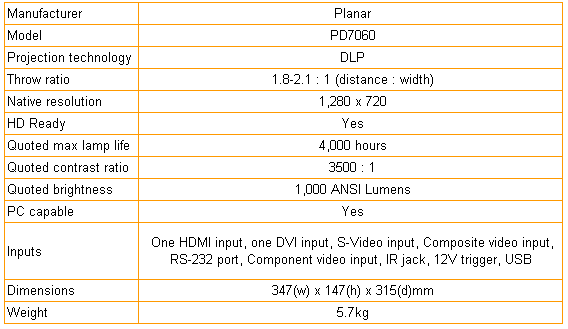Planar PD7060 Projector Review
Planar PD7060 Projector
Planar is making a habit of producing class-beating projectors for very good money. Here's another one...

Verdict
Key Specifications
- Review Price: £1750.00
A few months back we got our hands on the first product ever to emerge in the UK from respected US brand Planar. That product was a remarkably cheap and also very talented entry-level DLP projector, the PD7010.
So it’s fair to say we’re pretty intrigued to find out what Planar can do with the PD7060: a step-up, mid-range model that significantly ‘up-specs’ from the PD7010 while still only costing £1750 – a sum which, in the circumstances, looks very reasonable indeed.
From the outside, mind you, there’s really nothing to distinguish the PD7060 from its cheaper sibling. Both wear the same pleasing glossy black finish wrapped around the same vaguely circular design. Both also enjoy a relatively small and thus living room-friendly footprint, too.
The sibling similarities continue with the PD7060’s connections, which share the PD7010’s provision of two digital video inputs (one HDMI, one DVI), a PC port, and a trio of jacks – USB port, RS232 control port and 3.5mm remote control jack – included to aid integration of the PD7060 into a full home entertainment system. These latter three jacks are particularly important on the PD7060 because Planar is primarily targeting the projector at the custom installation market.
Where the PD7060 certainly does differ from the PD7010, though, is in its optical engine. Most significant is its use of a DarkChip 3 optical chipset from Texas Instruments rather than the older DarkChip 2 one found in the PD7010. This means that although it retains the same native resolution of 1,280 x 720, the PD7060 should produce a wider contrast range and sharper motion handling. Indeed, when it comes to contrast Planar claims a contrast ratio of 3,500:1 for the PD7060 versus 2,500:1 for the PD7010. This bodes particularly well for the PD7060 when you consider how conservative the PD7010’s 2,500:1 figure came to appear in the course of that review.
The PD7060’s colour wheel is a 6-segment, 4-speed affair, with image processing, rather surprisingly, relying on Texas Instruments’ own DDP3020 system. With many rival brands preferring to employ their own or more glamorous third-party image processing engines in their DLP projectors, it will be interesting to see how the TI system owns up. Mind you, Planar has apparently tinkered with the core DDP3020 engine quite considerably before letting the PD7060 roll…
Heading into the PD7060’s onscreen menus, handy features uncovered include three lamp output options (Eco, normal and boost); a trio of save-to-memory slots for storing your preferred image settings for different sources; various gamma presets designed for specific source types (such as games or movies); and even the facility to deactivate all over-scanning processing for a potentially cleaner 720-line picture. This latter feature arguably has limited value in the UK given how few HD sources we have that match the projector’s 720-line resolution, but we guess it might prove useful every now and then – especially to PC users.
In action, the PD7060 emphatically outperforms its PD7010 sibling – and pretty much anything else available at the same sort of money. 
Especially remarkable given its price and use of DLP – rather than the commonly slightly sharper LCD technology – is how phenomenally detailed high definition pictures look. With HD video sources such as ”Pirates of the Caribbean: The Curse of the Black Pearl” on Blu-ray, the projector reproduces every pixel of HD detailing with total noiseless precision. The impact of this clarity is even more pronounced when gaming on a PC, Xbox 360 or PS3, to the extent that we’d actually say the PD7060’s HD images look sharper than those of one or two ‘full HD’ projectors we’ve come across.
It does no harm to the sharpness of the PD7060’s pictures, either, that it handles moving objects rather more crisply than many DLP projectors in the sub-£2k bracket.
Nearly as impressive as the PD7060’s detailing are its black levels. Dark scenes suffer only marginally with the sort of greyness common to many budget projectors, and are certainly richer, deeper and more transparent, than those of the PD7010, good though that projector is for its money.
The combination of the PD7060’s impressive black levels and outstanding sharpness helps it portray scenes with a better sense of scale and image depth than usual too, especially since the natural, unforced nature of the black level response enables the projector to reproduce some unexpected subtleties of colour blend and shadow detail in even the darkest of corners.
Now that we’ve mentioned colour, we can report that the PD7060 handles that rather nicely too, achieving vivid saturations without compromising a video-friendly colour temperature that leaves most colour tones looking natural and believable.
Given the sharpness reported earlier, we expected to have some issues with video noise, but actually it proves remarkably free of the usual dot crawl and grain problems often associated with affordable projectors that focus on sharpness. And it’s also remarkably free of the fizzing noise over motion that still afflicts many DLP projectors to some extent, both budget and otherwise.
If you’re looking for reasons to spend more money on a higher-level projector than the PD7060, you can find them. For instance, we definitely noticed DLP’s rainbow effect from time to time, whereby stripes of red, green and blue flicker in your peripheral vision or appear over extreme areas of contrast. In fact, perhaps because of the PD7060’s greater brightness and contrast range we strangely felt slightly more aware of the rainbow effect here than we did on the PD7010.
Other minor hiccups include the occasional slightly off-key colour tone, especially during low-brightness scenes (though you can minimise this if you stick with the projector’s Cinema picture preset option), and a tendency to show sources ‘warts and all’. In other words, if a source is noisy the projector will tend to show it up for what it is – not such a bad thing for the signal quality purists, mind.
”’Verdict”’
You can, of course, get better DLP projectors than the PD7060 if you’re prepared to chuck enough cash around. But if £1,750 is simply as much as you can manage, the only other projector even in the same ballpark as Planar’s PD7060 is the outrageously good value InFocus IN78.

How we test televisions
We test every TV we review thoroughly over an extended period of time. We use industry standard tests to compare features properly. We’ll always tell you what we find. We never, ever, accept money to review a product.
Trusted Score
Score in detail
-
Value 10
-
Image Quality 9

